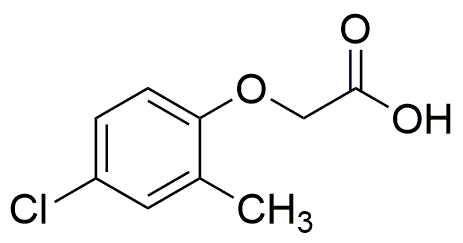(4-Chloro-2-methylphenoxy)acetic acid is widely utilized in research focused on:
- Agriculture: This compound serves as a herbicide, effectively controlling broadleaf weeds in various crops, which helps farmers improve yield and reduce competition for nutrients.
- Plant Growth Regulation: It is used to manipulate plant growth patterns, promoting desirable traits in crops, such as increased fruit size or improved flowering, benefiting horticulturists and agricultural scientists.
- Environmental Research: The chemical is employed in studies assessing the impact of herbicides on ecosystems, aiding researchers in understanding and mitigating environmental effects.
- Pharmaceutical Development: This compound is investigated for potential medicinal properties, contributing to the discovery of new therapeutic agents, particularly in the field of anti-inflammatory drugs.
- Analytical Chemistry: It is used as a standard in analytical methods for detecting and quantifying similar compounds in environmental samples, ensuring accurate assessments of chemical presence in soil and water.
Información general
Propiedades
Seguridad y normativas
Aplicaciones
(4-Chloro-2-methylphenoxy)acetic acid is widely utilized in research focused on:
- Agriculture: This compound serves as a herbicide, effectively controlling broadleaf weeds in various crops, which helps farmers improve yield and reduce competition for nutrients.
- Plant Growth Regulation: It is used to manipulate plant growth patterns, promoting desirable traits in crops, such as increased fruit size or improved flowering, benefiting horticulturists and agricultural scientists.
- Environmental Research: The chemical is employed in studies assessing the impact of herbicides on ecosystems, aiding researchers in understanding and mitigating environmental effects.
- Pharmaceutical Development: This compound is investigated for potential medicinal properties, contributing to the discovery of new therapeutic agents, particularly in the field of anti-inflammatory drugs.
- Analytical Chemistry: It is used as a standard in analytical methods for detecting and quantifying similar compounds in environmental samples, ensuring accurate assessments of chemical presence in soil and water.
Documentos
Hojas de datos de seguridad (HDS)
La SDS proporciona información de seguridad completa sobre la manipulación, el almacenamiento y la eliminación del producto.
Especificación del producto (PS)
La PS proporciona un desglose completo de las propiedades del producto, incluida la composición química, el estado físico, la pureza y los requisitos de almacenamiento. También detalla los rangos de calidad aceptables y las aplicaciones previstas del producto.
Certificados de análisis (COA)
Busque certificados de análisis (COA) ingresando el número de lote del producto. Los números de lote y de partida se pueden encontrar en la etiqueta de un producto después de las palabras "Lote" o "Lote".
Número de catálogo
Número de lote/lote
Certificados de origen (COO)
Este certificado de origen confirma el país en el que se fabricó el producto y también detalla los materiales y componentes utilizados en él y si se deriva de fuentes naturales, sintéticas u otras fuentes específicas. Este certificado puede ser necesario para cumplir con las normativas aduaneras, comerciales y regulatorias.
Número de catálogo
Número de lote/lote
Hojas de datos de seguridad (HDS)
La SDS proporciona información de seguridad completa sobre la manipulación, el almacenamiento y la eliminación del producto.
DownloadEspecificación del producto (PS)
La PS proporciona un desglose completo de las propiedades del producto, incluida la composición química, el estado físico, la pureza y los requisitos de almacenamiento. También detalla los rangos de calidad aceptables y las aplicaciones previstas del producto.
DownloadCertificados de análisis (COA)
Busque certificados de análisis (COA) ingresando el número de lote del producto. Los números de lote y de partida se pueden encontrar en la etiqueta de un producto después de las palabras "Lote" o "Lote".
Número de catálogo
Número de lote/lote
Certificados de origen (COO)
Este certificado de origen confirma el país en el que se fabricó el producto y también detalla los materiales y componentes utilizados en él y si se deriva de fuentes naturales, sintéticas u otras fuentes específicas. Este certificado puede ser necesario para cumplir con las normativas aduaneras, comerciales y regulatorias.


